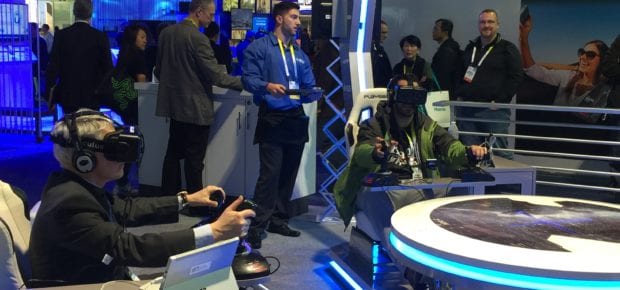January 21, 2016
Virtual reality (VR) was one of the hottest technologies at CES this year, alongside drones and the IoT. Major manufacturers flooded the showroom floor with new products and innovations, and the IEEE booth was no exception.
While passersby queued up to play our VR game — a Mars expedition where players worked together on a special mission — they were also able to demo other VR experiences thanks to IEEE member Todd Richmond and his team at the USC Institute for Creative Technologies (ICT). The ICT experience used viewers including Google Cardboard and Oculus Rift.
In addition to our hands-on VR experience, booth visitors were asked to fill out a survey that asked a range of questions regarding the future of AR/VR technology. The survey had 1,537 respondents, many of whom predict that VR headsets might not have the same staying power that is expected for virtual reality as a whole. In fact, 52% of respondents believed headsets could be phased out of immersive VR experiences by as early as 2030. Another 21% of respondents predicted this to be a reality by 2035, 15% by 2040 and 5% by 2045.
AR/VR Makes the Grade
Virtual reality has already made its mark on education, and 36% of show attendees surveyed predict that the benefit will grow as the technology continues to emerge.
“We are on the cusp of utilizing a technology that will have a profound effect on a variety of industries, such as education, healthcare and business,” shared Todd Richmond, director of advanced prototype development at the Institute of Creative Technologies at the University of Southern California. “Immersive capabilities such as AR, VR and mixed reality provide a whole new medium for communication and experience.Working in academia, I see endless possibilities to how augmented and virtual reality can enhance the learning experience by offering a more interactive element to information for students as well as act as another teaching tool for educators. It’s encouraging to see, based on the results of the survey, that consumers are able to align the value of this technology in other areas besides entertainment.”
What Happens Under the Knife, Stays Under the Knife
Despite the advantages of further integrating AR/VR in healthcare, the majority of survey respondents felt strongly against getting a “sneak preview” of surgical procedures through the advanced technology.
The Entertainment Factor
Virtual reality is inherently entertaining in that it can provide the experience of being practically anywhere, and with that in mind, we asked survey participants to rank where they would like to go first. Thirty percent of respondents chose the outer space as their primary destination, while time travel came as a close second at 19%, with sporting events (18%), a popular city (16%) and remote/secluded destinations (11%) trailing behind.
Virtual reality is still establishing itself across industries, and the majority (58%) of survey respondents predict that the US will be the first country to reach mass adoption, followed by Japan (21%), China (12%), with Brazil, India UK and “Other” (if desired country was not listed) as additional considerations, reflected in a small percentage of the results.
We’re excited to watch the world of VR continue to extend across industries, and hope that the predictions of our CES booth attendees hold true.





 Meaningful Momentum or Running in Place?
Meaningful Momentum or Running in Place? AI Through Our Ages
AI Through Our Ages Liquid Infrastructure: Our Planet's Most Precious Resource
Liquid Infrastructure: Our Planet's Most Precious Resource The Impact of Technology in 2025
The Impact of Technology in 2025 Quantum and AI: Safeguards or Threats to Cybersecurity?
Quantum and AI: Safeguards or Threats to Cybersecurity? Why AI Can't Live Without Us
Why AI Can't Live Without Us Bits, Bytes, Buildings and Bridges: Digital-Driven Infrastructure
Bits, Bytes, Buildings and Bridges: Digital-Driven Infrastructure Impact of Technology in 2024
Impact of Technology in 2024 Emerging AI Cybersecurity Challenges and Solutions
Emerging AI Cybersecurity Challenges and Solutions The Skies are Unlimited
The Skies are Unlimited Smart Cities 2030: How Tech is Reshaping Urbanscapes
Smart Cities 2030: How Tech is Reshaping Urbanscapes Impact of Technology 2023
Impact of Technology 2023 Cybersecurity for Life-Changing Innovations
Cybersecurity for Life-Changing Innovations Smarter Wearables Healthier Life
Smarter Wearables Healthier Life Infrastructure In Motion
Infrastructure In Motion The Impact of Tech in 2022 and Beyond
The Impact of Tech in 2022 and Beyond Cybersecurity, Technology and Protecting Our World
Cybersecurity, Technology and Protecting Our World How Technology Helps us Understand Our Health and Wellness
How Technology Helps us Understand Our Health and Wellness The Resilience of Humanity
The Resilience of Humanity Harnessing and Sustaining our Natural Resources
Harnessing and Sustaining our Natural Resources Creating Healthy Spaces Through Technology
Creating Healthy Spaces Through Technology Exceptional Infrastructure Challenges, Technology and Humanity
Exceptional Infrastructure Challenges, Technology and Humanity The Global Impact of IEEE's 802 Standards
The Global Impact of IEEE's 802 Standards Scenes of our Cyber Lives: The Security Threats and Technology Solutions Protecting Us
Scenes of our Cyber Lives: The Security Threats and Technology Solutions Protecting Us How Millennial Parents are Embracing Health and Wellness Technologies for Their Generation Alpha Kids
How Millennial Parents are Embracing Health and Wellness Technologies for Their Generation Alpha Kids Space Exploration, Technology and Our Lives
Space Exploration, Technology and Our Lives Global Innovation and the Environment
Global Innovation and the Environment How Technology, Privacy and Security are Changing Each Other (And Us)
How Technology, Privacy and Security are Changing Each Other (And Us) Find us in booth 31506, LVCC South Hall 3 and experience the Technology Moon Walk
Find us in booth 31506, LVCC South Hall 3 and experience the Technology Moon Walk Virtual and Mixed Reality
Virtual and Mixed Reality How Robots are Improving our Health
How Robots are Improving our Health IEEE Experts and the Robots They are Teaching
IEEE Experts and the Robots They are Teaching See how millennial parents around the world see AI impacting the lives of their tech-infused offspring
See how millennial parents around the world see AI impacting the lives of their tech-infused offspring Take the journey from farm to table and learn how IoT will help us reach the rising demand for food production
Take the journey from farm to table and learn how IoT will help us reach the rising demand for food production Watch technical experts discuss the latest cyber threats
Watch technical experts discuss the latest cyber threats Explore how researchers, teachers, explorers, healthcare and medical professionals use immersive technologies
Explore how researchers, teachers, explorers, healthcare and medical professionals use immersive technologies Follow the timeline to see how Generation AI will be impacted by technology
Follow the timeline to see how Generation AI will be impacted by technology Learn how your IoT data can be used by experiencing a day in a connected life
Learn how your IoT data can be used by experiencing a day in a connected life Listen to technical experts discuss the biggest security threats today
Listen to technical experts discuss the biggest security threats today See how tech has influenced and evolved with the Games
See how tech has influenced and evolved with the Games Enter our virtual home to explore the IoT (Internet of Things) technologies
Enter our virtual home to explore the IoT (Internet of Things) technologies Explore an interactive map showcasing exciting innovations in robotics
Explore an interactive map showcasing exciting innovations in robotics Interactively explore A.I. in recent Hollywood movies
Interactively explore A.I. in recent Hollywood movies Get immersed in technologies that will improve patients' lives
Get immersed in technologies that will improve patients' lives